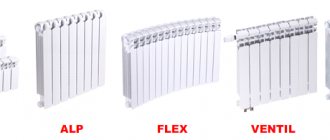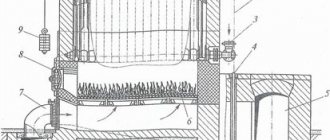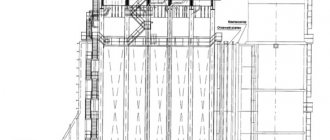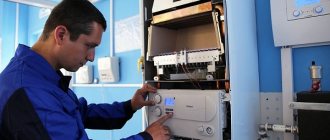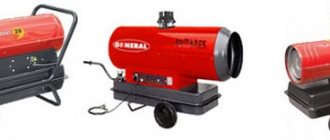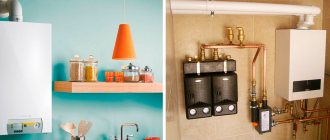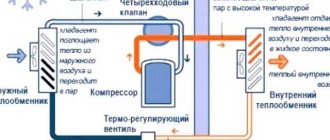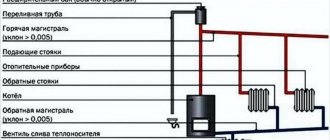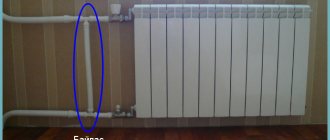Spending half of his life in heated rooms, sooner or later a person will glance at the heating radiator. When preparing to build a house or make major renovations in an apartment, you will have to think about whether you have chosen the right radiator. Or change your mind before it's too late. Install cast iron ones that you have known since childhood, or, like your neighbor’s, steel ones. And in the office - aluminum. But there are also bimetallic radiators, what are they? Let's try to understand, because there is still time. But first, we’ll have to briefly familiarize ourselves with other types of radiators, this will help us further.
These are the competitors of bimetal:
Cast iron is the grandfather of radiators.
But there is still gunpowder in the flasks. It heats up slowly, but takes a long time to cool down, which means it holds heat well. Heating interruptions will not scare you. Grandfather is not afraid of rust, God grant everyone has a service life. About fifty years old. The outdated appearance has recently been replaced by a modern, elegant one. Disadvantages - fragile, susceptible to impacts and heavy (one section weighs 8 kg), requires reinforced brackets. Steel radiators are more modern, their appearance is more pleasant. They warm up quickly, the volume of water circulating in them is small. The main advantage is the ability to withstand high water pressure, which is important in conditions of central heating. Let's remember this, just as we remember the disadvantage - low heat transfer.
Aluminum radiators are an even more modern look. It has a lot of advantages. They weigh little and are mounted on less durable brackets compared to cast iron and steel.
Warms up very quickly and is not subject to corrosion. And, remember this, it has the highest heat transfer among all competitors. Disadvantages: short service life and low operating pressure. Let's note this too.
Bimetallic radiator design.
So, here is the top of the radiator development chain - bimetallic. As the name suggests, the design uses two metals. Most often, steel and aluminum. There may also be a combination of copper and aluminum, but more on that later. What does the combination of two metals give? Look how the radiator is designed.
Its vertical and horizontal channels are made of steel, so the radiator has the advantages of steel competitors (remember) - the ability to withstand high water pressure. But the drawback is that the low heat transfer is made up precisely by aluminum, from which the casing of the product is made.
The advantages were inherited from steel and aluminum radiators. Steel core increases service life and working pressure. The pressure indicated by the manufacturers is from 20 to 35 atmospheres. Aluminum provides high heat transfer and protection against corrosion, and adds lightness to the structure. Service life – 20 years. Radiators are also produced in which only the vertical channels are made of steel, that is, water also flows through the aluminum tube. They are cheaper than the previously described model, but their operating pressure is no longer the same, and the disadvantage of a classic aluminum radiator appears. They are called semi-bimetallic or pseudo-bimetallic
Bimetallic or semi-bimetallic radiators
Bimetallic heating devices are steel pipes connected by cold welding, which are coated with a layer of aluminum. Thanks to this, hot water does not interact with the outer shell of the radiator, which avoids corrosion. Moreover, aluminum is applied in the form of shaped plates, and this significantly increases the heat transfer area.
There are also copper cores for bimetallic radiators. They are suitable if the coolant is water with antifreeze. This composition can quickly destroy steel, but copper is resistant to it.
Semi-bimetallic radiators have a core made of two metals. All vertical channels are steel, and horizontal ones are aluminum. The disadvantage of such devices is that they are not suitable for water with a high alkali content. They definitely require a coolant purified from impurities.
Now there are many different brands on the market offering high-quality antifreeze. One of them is Gibax brand antifreeze. When choosing, you must remember that ethylene glycol and propylene glycol bases are not used in systems with galvanized pipes. For them, coolants made on the basis of glycerin are used.
Now about which heating radiators are better. For central heating systems, bimetallic devices are more suitable because they are resistant to pressure drops and low-quality contaminated coolant.
For an apartment it is better to choose bimetallic heating devices Source homeli.ru
Semi-bimetallic radiators are more efficient, but they require ideal conditions to function properly. They are more suitable for private homes, and are an order of magnitude more expensive than bimetallic devices.
Details about the characteristics.
The parameters of bimetallic radiators are indicated in the product data sheet. Let's read it, having first understood the terminology.
Heat dissipation. The amount of heat that one section of the radiator gives off when the water temperature in it is 70°C. For cast iron and steel batteries, this figure does not exceed 100 W. The leader - aluminum sections, has a rating of 200 W. For bimetallic radiators, the figure ranges from 160 to 180 W. Not bad.
Limit coolant temperature. The ability of the radiator to withstand the declared temperature throughout its entire service life. Usually it is 90°C.
Operating pressure. We have already talked about it. Let's figure out what this indicator gives. For a low-rise residential building, with its own boiler with an operating pressure of 2-3 atmospheres, it is better, of course, to take an aluminum one. And cheaper and less heat transfer. Well, except that the service life is shorter. But in a central heating system the pressure reaches 10 atmospheres. The aluminum will break there. We'll have to install bimetal. Working pressure up to 35 atmospheres. But we carefully read the passport, there may be other numbers there. Especially if the horizontal channels are aluminum. Lifetime. Everything is clear from the name. Of course, a bimetallic radiator cannot compete with a cast-iron radiator with its lifespan of 50 years. But 20 years is not bad, compared to its aluminum competitor.
Aesthetic appearance. The lightness and elegance of the design, the elegance of the forms of a bimetallic radiator will give a hundred points ahead to cast iron and steel, but it can easily be confused with aluminum. Number of sections, center distance . The center-to-center distance shows how many millimeters the lower radiator collector is from the upper one. Standard values: 200, 300, 350, 500, 800 mm. The manufacturer produces batteries assembled from an even number of sections, usually from 4 to 12. But a qualified technician, if necessary, will reassemble your battery by connecting any number of sections together. The variety of sizes and thermal power of radiators will allow you to solve any problem of heating a room.
Types of bimetallic batteries
Bimetallic radiators are available in two types:
- Cast. In this case, the battery case is cast in special molds;
- Sectional. This option is assembled from separate sections, which are joined together using a threaded connection.
The convenience of sectional models lies in the ability to add new sections as needed. It will not be possible to enlarge a monolithic battery in this way, but due to the wide range of radiator sizes, they can be selected for any task.
The cost of monolithic models is 20-30% higher than sectional ones.
Both types of bimetallic heating radiators are used for heating installations in residential premises and administrative buildings. Which is better for an apartment depends primarily on the design of the heating network. For standard apartments in multi-storey buildings, it is better to use cast products, but in a country house, sectional ones can handle the load perfectly.
Disadvantages of bimetallic radiators.
Unfortunately, this section cannot be avoided. The main disadvantage is the price. The most expensive segment of the market. You have to pay for quality. Another drawback is due to the fact that the radiator core is made of steel. Therefore, they rust, especially when air enters the system. This disadvantage can be overcome by replacing the steel core with copper or stainless steel. However, this will further increase the cost of the product. It's up to you, you can buy any option.
Calculation of the number of battery sections.
For every square meter of area, 100 W of thermal power is required. Example, corner room, two windows and an area of 30 square meters. Power required (30 X 100) + 10% = 3300 W. We threw ten percent on the corner room. The same needs to be done for the first and last floors. We chose a radiator with a power of 170 watts per section. Thus, we will need 20 sections, 10 for each window. We take it with reserve. It’s better to ventilate once again in winter than to freeze. Our calculation is very approximate and is valid only for multi-storey residential buildings. If you are building your own separate house, then contact the designer. The specialist will make a calculation taking into account the thermal conductivity of your home.
Installation of heating radiators.
Installation of any devices must be carried out by a specialist. Bimetallic radiators are no exception. The radiator must be fixed strictly horizontally, level, at a distance of 200mm from the floor and from the window.
Each radiator must be equipped with a Mayevsky valve, a device that bleeds air from the heating system. Before installation, the system must be flushed to avoid dirt getting into the radiators.
Installation procedure: • mark the attachment points of the brackets, taking into account the requirements of the specific model, • strengthen the brackets with dowels, • install the radiator on the brackets in horizontal sections between the columns of the sections, • use a tap to connect the radiator to the heating circuit.
Here we will say a few words about increasing the efficiency of the radiator. Firstly, during installation you need to make sure that there are no burrs in the internal channel. In the future, it will serve as a water pressure dam. This is especially true for soft copper cores. Secondly, wet dust removal increases the heat transfer of the device. Thirdly, the battery should not be placed too close to the wall or floor. If the radiator's snow-white paint has faded or yellowed, it is not worth repainting annually; thermal conductivity may drop to almost zero under a thick layer of paint.
Did you know that by placing a reflective foil screen on the wall behind the radiator, you can seriously increase heat transfer.
It is also necessary to say something about the quality of water in the heating system. Pseudo-bimetallic radiators, like aluminum ones, suffer greatly from poor-quality water in the system. And very hard water can clog bimetallic products with scale. In central heating systems, the water is already properly prepared for use. In your home, you will have to take care of this yourself. We purify the water with a filter, let it settle, and reduce the hardness with the help of chemicals (for example, AquaShield softener).
Manufacturers of bimetallic radiators.
The Russian company Rifar offers good pseudo-bimetallic batteries. Its products, having conquered the Russian market, were exported. It produces seven types of radiators. Popular models are “Rifar Flex”, “Monolith”. The color of the radiators is white. The number of sections in the battery is from 4 to 14 pieces. Rifar provides a guarantee for products from 10 to 25 years.
The German company TENRAD offers a completely bimetallic design in its products.
Innovative solutions of German engineers are protected by patents, including in the Russian Federation. TENRAD BM radiators are available with an interaxial distance of connecting pipes of 500 and 350 mm.
Reliable batteries are offered by the Italian company Global Style. The technical characteristics of their products can be called industry benchmarks. Such models include Global Style Extra and Global Style Plus radiators. But you have to pay for elitism; Global Style batteries are not cheap. Radiators are produced with an interaxal distance of 350 and 500 mm, with the number of sections from 6 to 14 pcs. The manufacturer offers a warranty of 10 to 20 years.
The British company BiLUX offers highly efficient bimetallic radiators. Models are available with center distances of 200, 350 and 500 mm. The battery design is highly reliable, with a 10-year manufacturer's warranty.
Popular models of bimetallic radiators on the market.
There are a large number of heating batteries of foreign and domestic production on the Russian market. One small piece of advice: if you choose a monolithic battery, then take a domestic one, a sectional one – an Italian one with high pressure.
Table of the main popular models.
Comparative table of popular models of bimetallic radiators.
